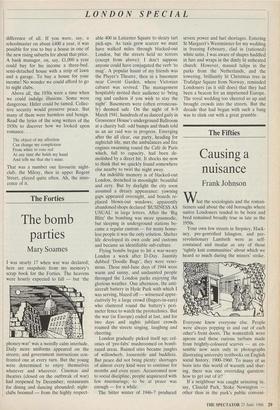The Forties
The bomb parties
Mary So ames
I was nearly 17 when war was declared; here are snapshots from my memory's scrap book for the Forties. The heavens were hourly expected to fall — but 'the phoney-war' was a weirdly calm interlude. Daily more uniforms appeared on the streets; and government instructions con- fronted one at every turn. But the young were determined to enjoy themselves whatever and wherever. Cinemas and theatres (closed on the outbreak of war) had reopened by December; restaurants for dining and dancing abounded; night- clubs boomed — from the highly respect- able 400 in Leicester Square to sleazy tart pick-ups. As taxis grew scarcer we must have walked miles through blacked-out London, but the streets held no terrors (except from above): I don't suppose anyone could have conjugated the verb `to mug'. A popular haunt of my friends was the Player's Theatre, then in a basement near Covent Garden, where Victorian cabaret was revived. The management hospitably invited their audience to 'bring rug and cushion if you wish to stay the night'. Basements were (often erroneous- ly) deemed safe. On the night of 8-9 March 1941, hundreds of us danced gaily in Grosvenor House's underground Ballroom at a charity ball: odd bumps and thuds told us an air raid was in progress. Emerging after the all clear, our party, heading for nightclub life, met the ambulances and fire engines swarming round the Café de Paris which, full to capacity, had been de- molished by a direct hit. It shocks me now to think that we quickly found somewhere else nearby to twirl the night away.
An indelible memory is of blacked-out London, drenched in moonlight: beautiful and eery. But by daylight the city soon assumed a dreary appearance: yawning gaps appeared overnight, and boards re- placed blown-out windows; apparently abandoned shops declared 'BUSINESS AS USUAL' in large letters. After the 'Big Blitz' the bombing was more spasmodic, but sleeping in underground stations be- came a regular custom — for many home- less people it was the only solution. Shelter life developed its own code and customs and became an identifiable sub-culture.
Flying bombs began to hit a war-weary London a week after D-Day. Jauntily dubbed 'Doodle Bugs', they were veno- mous. Those mid-June days of 1944 were warm and sunny, and undaunted people thronged the London parks enjoying the glorious weather. One afternoon, the anti- aircraft battery in Hyde Park with which I was serving, blazed off — witnessed appre- ciatively by a large crowd (fingers-in-ears) who clustered round the battery's peri- meter fence to watch the pyrotechnics. But the war (in Europe) ended at last, and for two days and nights jubilant crowds roamed the streets singing, laughing and cheering.
London gradually picked itself up; col- onies of 'pre-fabs' mushroomed on bomb- razed areas. Ruined sites became jungles of willowherb, loosestrife and buddleia. But peace did not bring plenty: shortages of almost every kind were to continue for months and even years. Accustomed now to social discipline, people acquiesced with few murmurings; to be at peace was enough — for a while.
The bitter winter of 1946-7 produced severe power and fuel shortages. Entering St Margaret's Westminster for my wedding in freezing February, clad in (rationed) white satin, I was aware of shapes huddled in furs and wraps in the dimly lit unheated church. However, massed tulips in the parks from the Netherlands, and the towering, brilliantly lit Christmas tree in Trafalgar Square from Norway, reminded Londoners (as it still does) that they had been a beacon for an imprisoned Europe. The royal wedding too cheered us up and brought crowds into the streets. But the decade that had begun with such a bang was to slink out with a great grumble.










































































 Previous page
Previous page